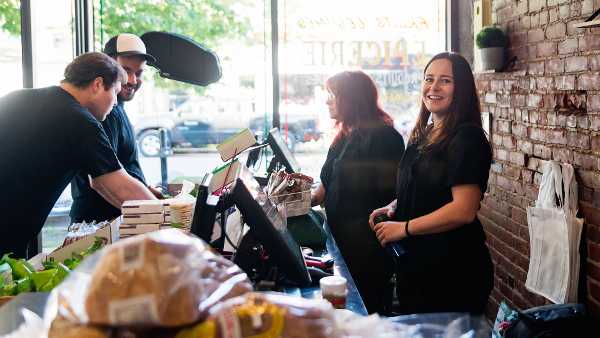What you must do if you produce or import single-use plastic products
- Danitsja Kallendorf
- Background
- 26 October 2023
- Edited 16 June 2025
- 4 min
- Managing and growing
- Sustainability
Every hour, enough plastic ends up in the sea to fill 11 Olympic-sized swimming pools. Most of that litter is made up of single-use plastic products. Balloons, bags, and cups for example. Are you a producer or importer of single-use plastic products? Then chances are that the Extended Producer Responsibility (EPR) for litter applies to you. This means you must help pay to clean up litter.
The EPR Litter was introduced in 2023 to combat plastic litter in the environment. An EPR (uitgebreide producentenverantwoordelijkheid, UPV in Dutch) means that as a producer and importer, you contribute financially to the waste management of products you put on the market. And that you encourage your customers to dispose of your products correctly, and not to litter. Rijkswaterstaat implements the EPR on behalf of the Ministry of Infrastructure and Water Management.
EPR also applies to other products, such as textiles, batteries, and car tyres.
Does the EPR apply to me?
Whether you call them single-use, disposable, or throw-away products, within the EPR, they all fall under the term ‘single-use plastic products’. Are you a manufacturer or importer of such products? Then you must contribute financially to the EPR. The EPR also applies to you if you, as a customer, have your name, brand or logo printed on disposable products or packaging. For example, if you have your store's name printed on a plastic bag.
Caps must be attached to plastic bottles
You must also follow other rules aimed at reducing litter. Producers and importers of drinks in plastic bottles and containers must ensure the caps and lids are . This way, the caps are automatically returned for recycling and do not end up as litter.
What products does the EPR for litter apply to?
The EPR for litter covers the 10 single-use plastic products you find a lot of in litter. Balloons, bags, and wrappers for example. The EPR distinguishes between 2 types of plastic: single-use plastic packaging and single-use plastic products.
The single-use plastic packaging covered by the EPR includes:
- plastic food packaging
- drink containers and bottles of three litres or less
- plastic drinking cups
- plastic bags and wrappers
- light plastic carrier bags
The EPR for Litter also applies to several disposable products:
- balloons
- wet wipes
- tobacco products with filter and loose filters.
The EPR for litter applies to these products
The EPR for litter applies to the following products:
- plastic food packaging
- drink containers and bottles of up to 3 litres
- plastic drinking cups
- plastic bags and wrappers
- light plastic carrier bags
- balloons
- wet wipes
- tobacco products with filter and loose filters.
Sanitary towels and tampons also fall within the EPR. For these products you do not have to pay for cleaning up litter and collecting waste. However, you must encourage consumers to prevent littering.
EPR Packaging
As well as the EPR for litter, there is an EPR for . This applies, for example, to glass jam jars, vegetable tins, and pizza boxes. There is an important difference between the two EPRs. You only have to comply with the EPR for packaging if you produce or import more than 50,000 kg of packaging. There is no minimum quantity for the EPR for litter.
How do you comply with the EPR obligations?
You can comply with the EPR obligations in 2 ways: through a producers’ organisation, or independently. The method that suits your situation depends on the type of disposable plastic you are putting on the market.
Your first step is always to report to the producers’ organisation, the Packaging Waste (Afvalfonds Verpakkingen), or (in Dutch) about the amount of plastic you put on the market. Then you pay to clean up the litter. You will receive an annual invoice from the Packaging Waste Fund. How you pay if you are a producer of plastic products such as balloons is not yet known. In addition, you must encourage customers to prevent litter. If you fail to comply with the EPR obligations you risk a fine. The Human Environment and Transport (Inspectie Leefomgeving en Transport, ILT) actively keeps track of which parties have reporting obligations.
Registering plastic packaging
Do you put plastic packaging on the market as an importer or producer? If so, you must register with the Packaging Waste . After registering, you indicate how much plastic packaging you have brought onto the market in a year. You must do this every year. The Packaging Waste Fund ensures that importers’ and producers’ data on plastic packaging is passed to Rijkswaterstaat. The producers’ organisation also handles all the other EPR Litter obligations. Such as reporting to Rijkswaterstaat on the amount of plastic put on the Dutch market. And payments to municipalities and public area managers.
Registering plastic products
There is no producers’ organisation for the other types of plastic products. This means that you must comply with the EPR yourself. You register once with Rijkswaterstaat using the EPR for litter notification (in Dutch). There are separate reporting forms for balloons, wet wipes, and tobacco products with filters or loose filters.
You pay for cleaning up litter
Cleaning up litter is expensive. Research by Rijkswaterstaat shows that it costs the Netherlands €304 million annually. Municipalities used to pay most of that. The introduction of the EPR for litter shifts those costs to the producers and importers. For each product you put on the market, you pay a fixed amount. The price varies per product. Rijkswaterstaat publishes the price per plastic (in Dutch) on 1 June of each year. You pay retrospectively, so for the year 2025, you pay in 2026. Are you registered with the Waste Management Fund? Then the payment goes through this organisation. And you do pay in the same year. You will receive an invoice based on the declaration you submit to the Waste Fund.
Encourage consumers to prevent littering
When it comes to litter, cleaning up is good but prevention is better. Therefore, as a producer or importer of disposable plastic, you must let your customers know that plastic litter causes damage. To do this, you must make an 'awareness plan'. That plan sets out how you encourage customers to dispose of plastic products properly. This can include measures such as giving instructions or organising a clean-up day. You decide what the plan should be. Is your plan ready? Mail it to . You make a new awareness plan every 3 years. For plastic packaging, you fulfil this obligation through the Waste Management Fund.
Use the 'disposable plastic' logo on your product
Always communicate clearly on your product that it contains plastic and the environmental and health hazards it can cause. You can do this by using the special .
Submit an annual report
Are you registered for the EPR for litter, but there is no producers’ organisation for your product? Then you have to submit an annual report on how you meet your EPR obligations. You must submit a (in Dutch, scroll down to the yellow box for the forms) before 1 April. In the form you explain how you comply with the EPR obligations and how much disposable plastic you put on the market.

